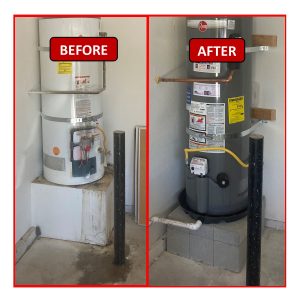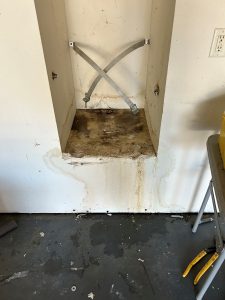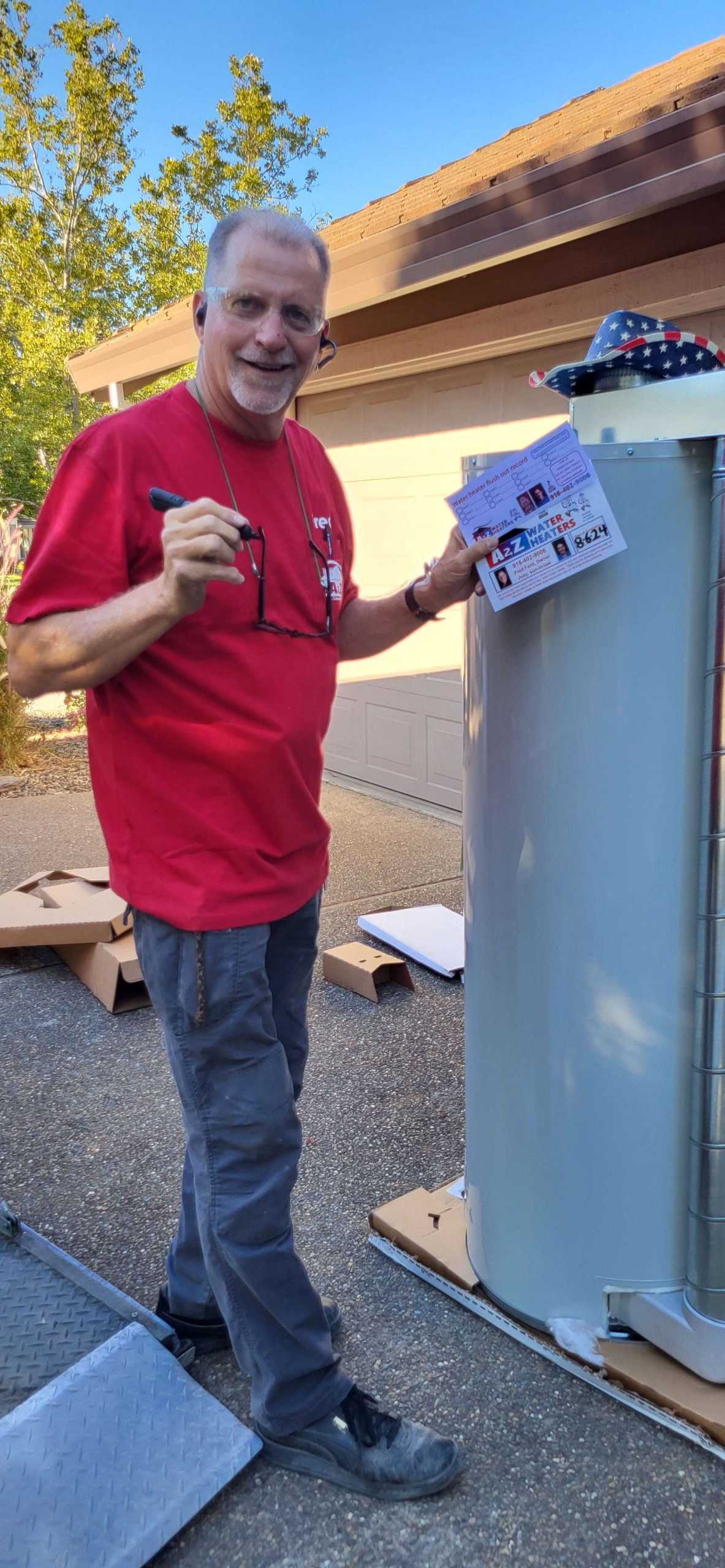
When installing a water heater, the stand it rests on is often overlooked but plays a critical role in safety, efficiency, and longevity. At A2Z Water Heaters, we pride ourselves on making choices that prioritize the well-being of our customers and the durability of their installations. One such choice is our preference for building water heater stands using cinderblocks. This comprehensive guide will explore the necessity of water heater stands, the types available, and why we believe cinderblock stands are the best option for your home.
Why Are Water Heater Stands Necessary?
Water heater stands are required in many situations to ensure safety and compliance with building codes. Understanding when and why these stands are necessary is crucial:
- Elevation for Safety: Water heaters, must be elevated off the ground when installed in a garage. This requirement is in place to prevent the ignition of flammable vapors, such as those from gasoline or paint thinners, which tend to accumulate near the floor. California building codes, among the strictest in the nation, mandate this elevation to minimize fire risks.
- Electrical Safety for Electric Water Heaters: It’s not just gas water heaters that require elevation. Electric water heaters installed in garages must also be placed on a stand. This is because electrical connections should not be located closer than 18 inches to the ground in any garage where vehicles are parked. This regulation is designed to prevent electrical hazards, such as short circuits or electrical fires, that could occur if the connection were too close to potentially flammable substances on the floor.
- Drainage Considerations: If a water heater is installed inside the home, a stand is not technically required. However, all water heaters must have a drain pan, and this pan must be plumbed to the outside of the house to prevent water damage in the event of a leak. In a garage setting, the stand allows for easier plumbing of the drain pan to either the floor or the exterior, further protecting your property from potential water damage.
- Code Compliance: In California, the building codes are clear: whether your water heater is gas or electric, if it’s located in the garage, it must be installed on a stand. This regulation ensures that your installation meets safety standards and that your home remains compliant with local laws, which is especially important when selling or insuring your property.
- Preventing Damage: Elevating the water heater reduces its exposure to potentially damaging elements, such as moisture, dust, and debris that can accumulate on the garage floor. This elevation helps prolong the life of the water heater by limiting rust and corrosion.
Types of Water Heater Stands
When it comes to choosing a water heater stand, homeowners typically have two options: wood or metal. But our preferred option of cinderblocks gives customers another option. Each type comes with its own set of advantages and disadvantages, which we’ll explore in detail.
-
Wood Water Heater Stands
Wooden stands are a common choice due to their availability and ease of construction. However, they present several significant issues:
- Susceptibility to Rot and Mold: Wood is highly susceptible to moisture damage. If the water heater leaks, the wood can rot, leading to a weakened stand. Additionally, moisture trapped in the wood can promote mold growth, which poses health risks and can spread to other areas of your home.
- Structural Concerns: While wood can be sturdy, it may not provide the long-term durability needed for supporting a heavy water heater, particularly in areas with high humidity or fluctuating temperatures. Over time, the wood can warp or sag, compromising the safety of the installation.
- Maintenance Requirements: Wooden stands require regular inspections and maintenance to ensure they remain safe and functional. This adds ongoing costs and effort for homeowners, making wood a less desirable option in the long run.
-
Metal Water Heater Stands
Metal stands are often chosen for their durability and strength. However, they are not without their drawbacks:
- Lack of Built-In Sides: According to safety regulations, water heater stands must have sides to prevent items from being stored underneath. This is crucial because flammable materials, such as gasoline cans, can become fuel for a fire or cause an explosion if stored under the water heater. Most metal stands do not come with sides, necessitating the construction of custom barriers, which increases both the cost and complexity of the installation.
- Customization Challenges: Before we switched to cinderblock stands, we used to custom-build sides for metal stands using various materials, including aluminum sheet metal. This was a tedious and time-consuming process that often resulted in wasted material and increased costs for our customers. While aluminum sheet metal is resistant to rust, it can be challenging to work with, and constructing custom sides requires precision and expertise. These challenges further highlighted the need for a more efficient and reliable solution.
- Cost and Waste: Customizing metal stands with additional sides and supports can be expensive. The process not only adds to the overall cost of the installation but also leads to wasted materials, as cutting and fitting sheet metal to the exact specifications of each stand often results in excess scraps.
-
Cinderblock Water Heater Stands
At A2Z Water Heaters, we’ve found that cinderblock stands offer the most advantages, combining durability, safety, and cost-effectiveness. Here’s why we prefer to build our water heater stands using cinderblocks:
- Unmatched Durability: Cinderblocks are incredibly sturdy and can easily support the weight of any water heater, whether it’s a small electric unit or a larger gas model. They are resistant to rot, rust, and other forms of deterioration, making them a long-lasting option for any home.
- Water Resistance: Cinderblocks are impervious to water damage, which is a significant advantage over wood and metal. If a water heater leaks, the cinderblock stand remains intact, preventing the structural issues that can occur with other materials.
- Built-In Safety: One of the biggest advantages of cinderblock stands is that they naturally prevent items from being stored underneath the water heater, eliminating the need for custom-built sides. This feature ensures compliance with safety regulations and reduces the risk of fire or explosion, making it the safest option available.
- Ease of Construction: Building a cinderblock stand is straightforward and can be done quickly by experienced professionals like those at A2Z Water Heaters. The simplicity of the construction process allows us to install your water heater safely and efficiently without unnecessary delays or complications.
- Cost-Effective: Cinderblocks are an affordable material, providing excellent value for their durability and safety. This allows us to keep installation costs reasonable while still delivering a high-quality, long-lasting solution.
- Low Maintenance: Once installed, a cinderblock stand requires little to no maintenance. Unlike wood, which may need regular inspections and repairs, or metal, which may rust over time, cinderblocks remain solid and reliable for years to come.
Repairing or Replacing Existing Stands
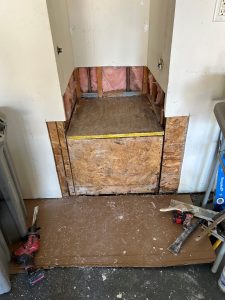
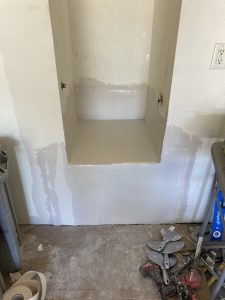
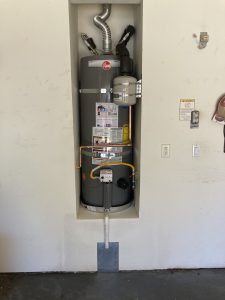
The Role of California Building Codes
California has some of the strictest building codes in the country, and these regulations play a significant role in how water heaters are installed. Whether your water heater is gas or electric, if it’s located in a garage, it must be installed on a stand. This rule is part of California’s comprehensive approach to safety, ensuring that all installations meet the highest standards to protect homeowners and their properties.
At A2Z Water Heaters, we are fully compliant with California’s building codes. Our use of cinderblock stands not only meets these requirements but often exceeds them, providing an extra layer of safety and durability that goes beyond the minimum standards.
Why A2Z Water Heaters Chooses Cinderblock Stands
Our commitment to quality and customer satisfaction drives every decision we make at A2Z Water Heaters. We’ve chosen cinderblock stands for our installations because they offer the best combination of durability, safety, and cost-effectiveness. Here’s why we stand by this choice:
- Customer Safety: Safety is our top priority, and cinderblock stands provide the most secure foundation for your water heater. By preventing items from being stored underneath the unit, cinderblock stands minimize the risk of fire or explosion, ensuring the safety of your home and family.
- Long-Term Durability: We believe in providing solutions that stand the test of time. Cinderblock stands are resistant to the elements, water damage, and wear and tear, meaning they will remain strong and reliable for decades.
- Efficient Installation: Our team is skilled in constructing cinderblock stands quickly and efficiently, allowing us to complete your water heater installation with minimal disruption to your daily life. The ease of construction also helps keep costs down, providing excellent value for our customers.
- Cost Savings: Cinderblocks are a cost-effective material, allowing us to offer competitive pricing without compromising on quality. Additionally, the low maintenance requirements of cinderblock stands mean fewer costs for you in the long run.
- Compliance with Codes: By using cinderblocks, we ensure that your water heater installation meets all local building codes and safety regulations. This gives you peace of mind knowing that your installation is up to standard and that you won’t face any issues during inspections or when selling your home.
Conclusion: The Best Stand for Your Water Heater
Choosing the right water heater stand is more than just a matter of preference; it’s a decision that impacts the safety, durability, and overall cost of your installation. While wood and metal stands have their uses, they come with significant drawbacks that make them less than ideal for most homes. At A2Z Water Heaters, we believe that cinderblock stands offer the best combination of benefits, providing unmatched durability, safety, and value for our customers.
If you’re considering a water heater installation or replacement, don’t settle for anything less than the best. Call Fred on his personal phone at 916-402-9006, and let our team at A2Z Water Heaters provide you with a sturdy, safe, and long-lasting cinderblock stand that will protect your home and water heater for years to come. With our expertise and commitment to quality, you can trust that your installation will be done right the first time.
